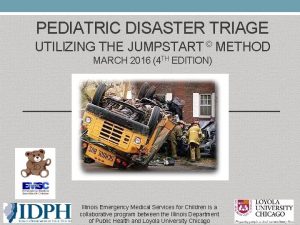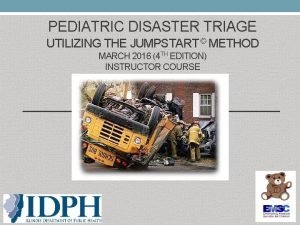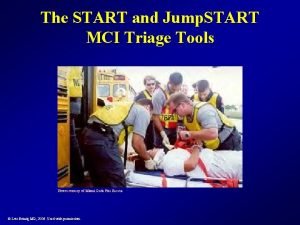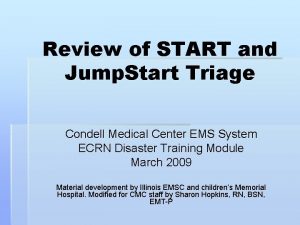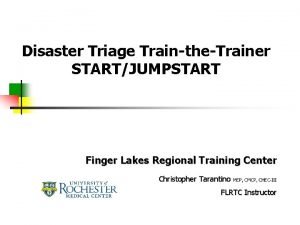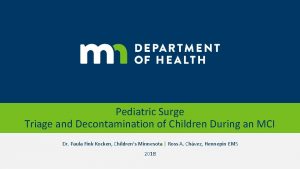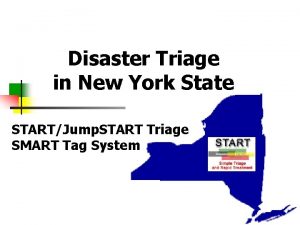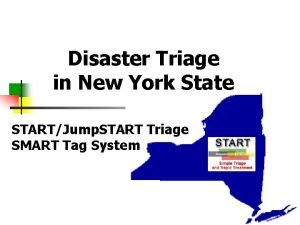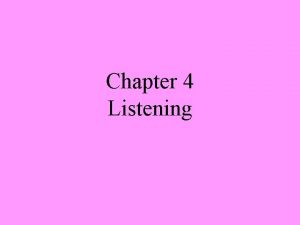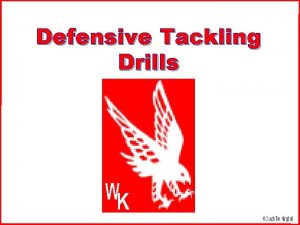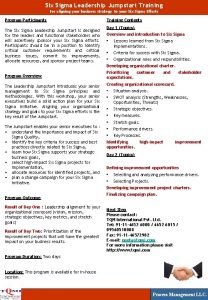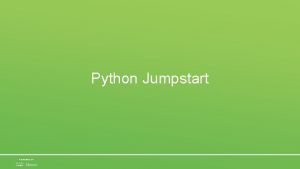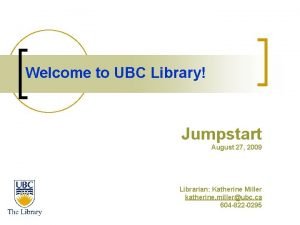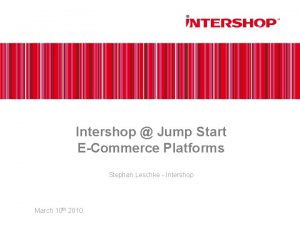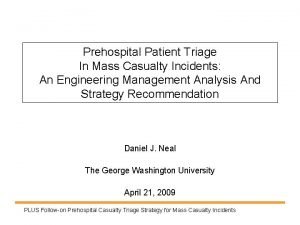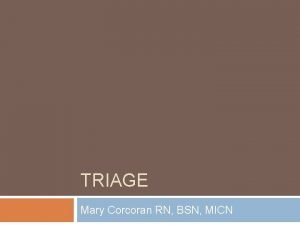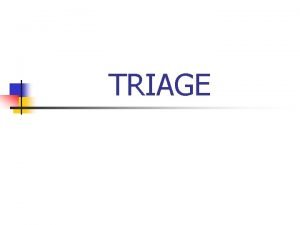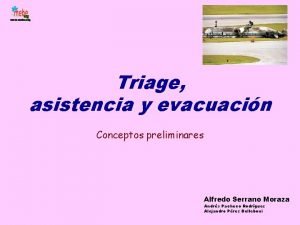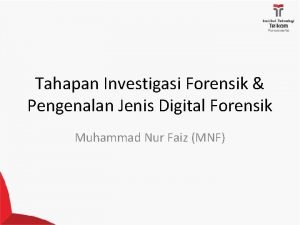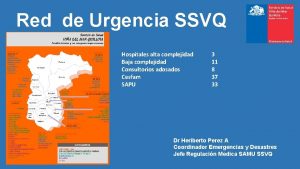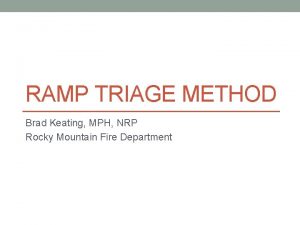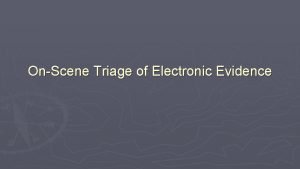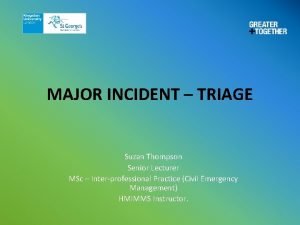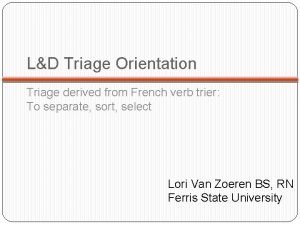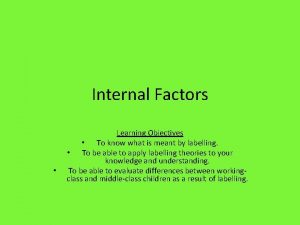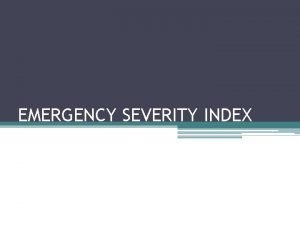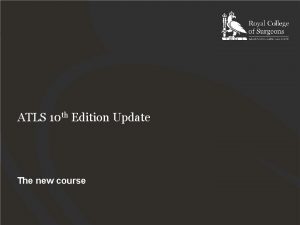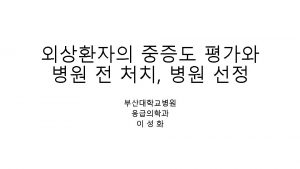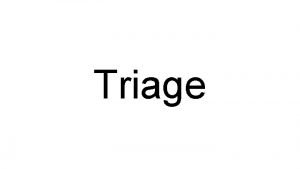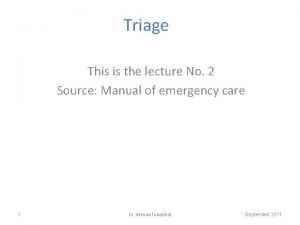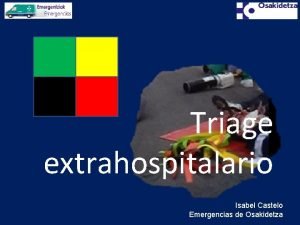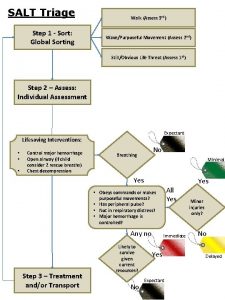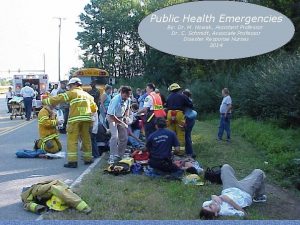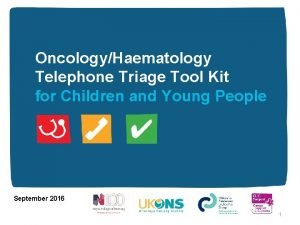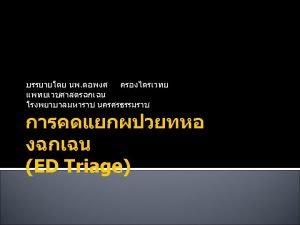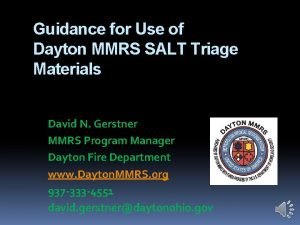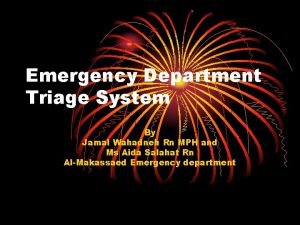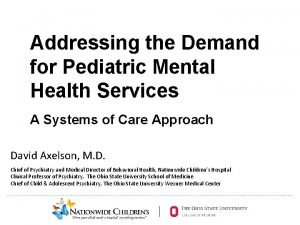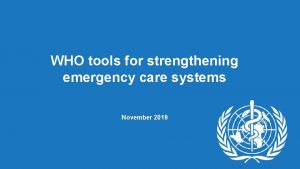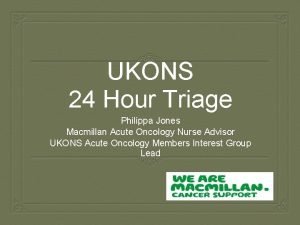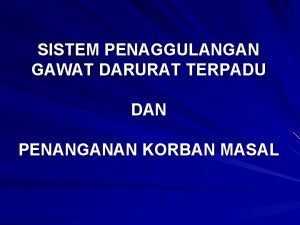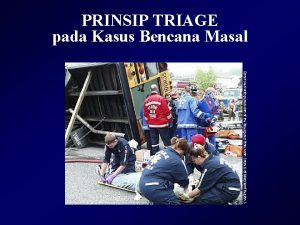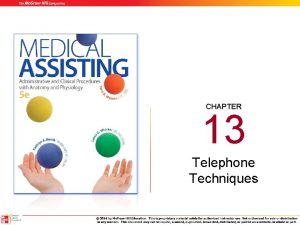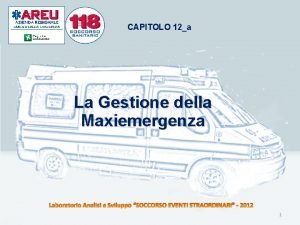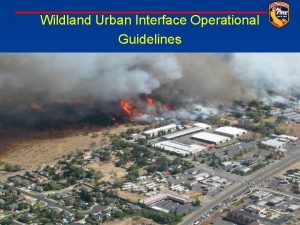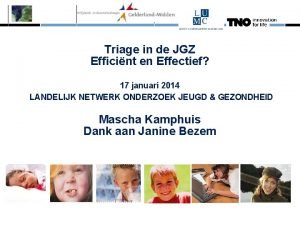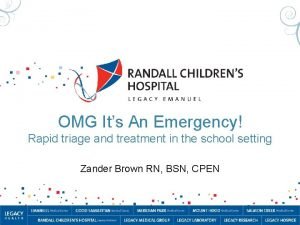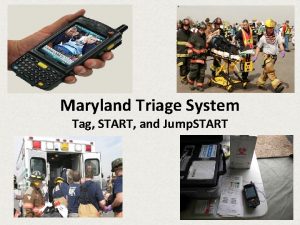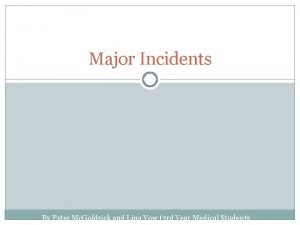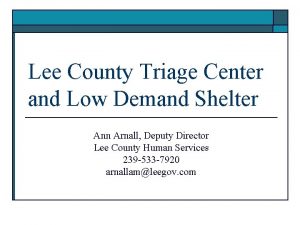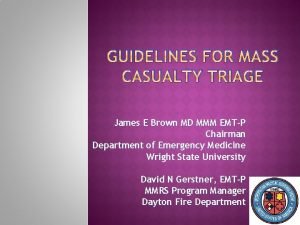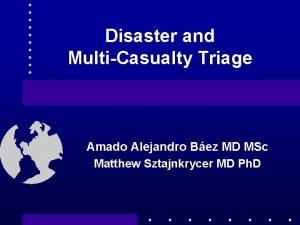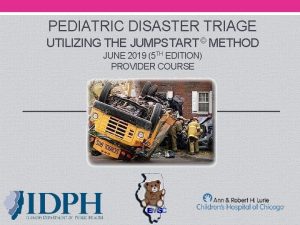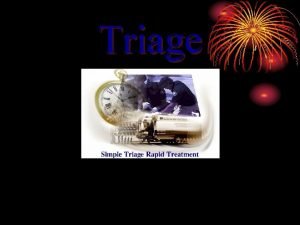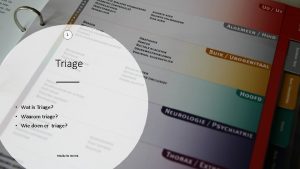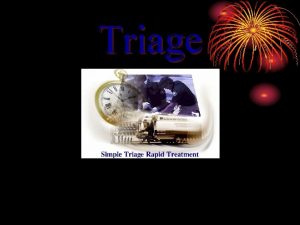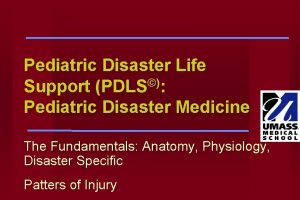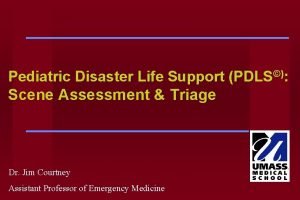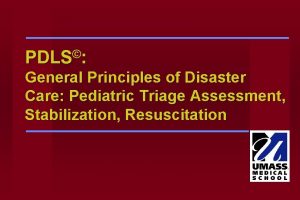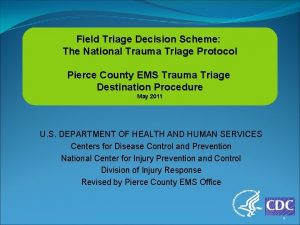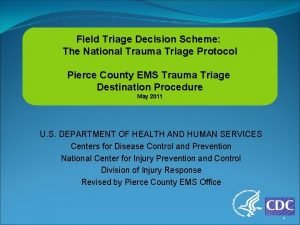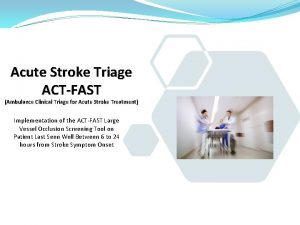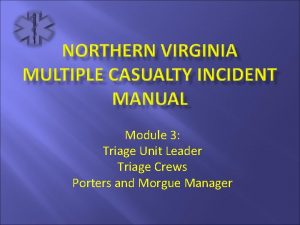PEDIATRIC DISASTER TRIAGE UTILIZING THE JUMPSTART METHOD MARCH













































































































- Slides: 109

PEDIATRIC DISASTER TRIAGE UTILIZING THE JUMPSTART © METHOD MARCH 2016 (4 TH EDITION) Illinois Emergency Medical Services for Children is a collaborative program between the Illinois Department of Public Health and Loyola University Chicago

Disclaimer This slide set and all related training information provided in this session is in accordance with current practice at the time that this program was developed.

Acknowledgements • This 4 th edition education program was developed under the direction and guidance of the Illinois Pediatric Preparedness Workgroup. The original program was adapted in 2006 from a module developed by Children’s Memorial Hospital (now Ann & Robert H. Lurie Children’s Hospital of Chicago). • This program was developed from an Assistant Secretary for Preparedness and Response (ASPR) Hospital Preparedness Program (HPP) grant. All training materials are considered under public domain and can be utilized by others in the conduction of similar educational programs, provided there is acknowledgement of the source of these materials.

Objectives • Identify unique characteristics that make children more vulnerable in a disaster • Discuss mass casualty triage and the pediatric patient • Review START and Jump. START© Triage Tools and the SMART Triage Pacs™ • Demonstrate the use of the START and Jump. START© Triage Tool

Objectives (continued) • Discuss the instructor role for Jump. START© Triage Training • Identify Healthcare Professionals in your EMS Region to target for Jump. START© Triage training • Discuss the necessary steps to teach a Jump. START© Provider and Instructor Class • Review the training materials that are necessary to teach a Jump. START© Provider and Instructor Class

Introduction

Background Illinois Emergency Medical Services for Children (EMSC) 1984: National EMSC Program established through federal legislation • Jointly sponsored by • Maternal & Child Health Bureau • National Highway Traffic Safety Administration • States are charged with enhancing the pediatric component of their Emergency Medical Services (EMS) systems. 1994: Illinois EMSC was established.

Illinois EMSC Pediatric Disaster Preparedness • 2002: • Illinois Pediatric Bioterrorism Workgroup convened • Name changed in 2011 to Pediatric Preparedness Workgroup to ensure a more all-hazards approach. • Reports to EMSC Advisory Board and Illinois Terrorism Task Force • Assists in assuring that the special needs of children are addressed during a disaster or terrorist event by: • Enhancing awareness of pediatric needs • Identifying/sharing best practices • Developing resource documents, tools, and guidelines • Integrating disaster preparedness into existing state initiatives

Illinois Communities • Illinois is the 5 th most populous state with a population of 12. 9 million • Almost 3 million children <18 years of age • Approximately 800, 000 are age five and younger.

Children and Disasters

Disaster “A medical disaster occurs when the destructive effects of natural or man made forces overwhelm the ability of a given area or community to meet the demand for health care. ” (Source: ACEP Disaster Medical Services Policy Statement, 2006)

Natural Disasters • Earthquake • Flood • Snow/ice storm • Tornado • Others

Human Caused Disasters • Terrorist Events • Arson • Bombings • Shootings • Use of chemical, biological or nuclear agents • Hazmat incidents

Terrorist Events and the Pediatric Population Myth Kids are secondary victims of terrorism and inadvertently targeted Fact Children may be intentionally targeted

Harsh Realities: Children as Victims of Disasters • 1984: Bhopal, India – Industrial gas release (methyl isocyanate) – Estimated 20% of victims were children • 1999: Columbine High School Shootings – 12 students killed, 24 injured • 2004: Beslan, Russia – Three day hostage event at school – 334 hostages killed including 186 (56%) children • 2011: Oslo and Utoya Norway Attacks – At least 60 children killed after a gunman opened fire at a youth summer camp • 2012: Sandy Hook Elementary School Shooting – 26 people killed (20 children and 6 adults)

Why Children are More Vulnerable During Disasters Lack of appropriate sized equipment and supplies Challenges related to medical interventions and safety Gaps in pediatric preparedness in hospitals, agencies, communities, and on the state and federal levels Anatomical, physiological and developmental differences Critical emergency care interventions performed infrequently Increased vulnerability during disasters May be intentionally targeted during the disaster

Respiratory Airway is smaller and more narrow Higher risk for respiratory issues Depend on diaphragm to breath Equipment needs vary based on size

Exposure Faster respiratory rates More susceptible to: infections effects of agents prolonged exposures hypothermia Thinner skin/ greater body surface area Shorter stature Faster metabolism Immature immune system

Trauma Rib cage is higher Higher risk for injury, irreversible shock and death from traumatic events Larger head/higher center of gravity Smaller circulating blood volume

Developmental May lack cognitive ability to sense a dangerous situation Increased exposure and risk of injuries May lack motor skills to flee from danger

Developmental May be nonverbal or not know personal information Age & developmental level influences response to stressful events May be uncooperative Unable to help with reunification Long term psychological effects are possible

Children with Special Health Care Needs (CSHCN)/Children with Functional Access Needs (CFAN) • Can include those kids who are/have: • Technology dependent • • • 23% of U. S. households have at least 1 child that meet criteria • 15. 1% (>11. 2 million) children in U. S. meet criteria • Illinois: 14. 3% (452, 574) (ventilators, G-tubes, shunts, insulin pumps) Developmentally delayed or disabled Chronic diseases Immunocompromised Psychiatric/behavioral illnesses • Many emergency personnel and disaster responders are not used to dealing with this population

Triage

Triage • • • Sorting and prioritizing patients Looks at the medical needs and urgency of each individual patient Conventional Triage • • Do the best for each individual Disaster/MCI Triage Do the greatest good for the greatest number • Based on physiology • Provides an objective framework for stressful and emotional decisions • Helps in resource allocation •

Triage • Primary Triage • • Typically performed at the scene of the incident Helps prioritize patients for evacuation/transport Can occur at a hospital Secondary Triage • • • Performed to re-evaluate the patient after primary triage has been completed Typically done once the patient arrives at the hospital. Can also take place at an alternate care site or at the scene of the incident if prolonged scene time or in casualty collection areas

Mass Casualty Incident Any incident in which there are more patients than rescuers (Source: newyearseve. com)

~80% of casualties self or buddy transport to the closest hospital

MCI Triage • All victims must have equal importance at the time of primary triage • Sort patients based on the need for immediate care • Be able to recognize futility • No patient group can receive special consideration other than that dictated by their physiologic state This includes children! (Source: Dr. Lou Romig-slide presentation: Jump. START Pediatric Multi-casualty Triage System)

MCI Triage Categories • IMMEDIATE = Emergent IMMEDIATE • DELAYED = Urgent DELAYED • MINOR = Non-urgent/walking MINOR wounded • EXPECTANT/DECEASED = Dead/little to no hope of survival

IMMEDIATE Severely ill/injured but treatable and able to be saved with relatively quick treatment and transport • Examples: • Severe bleeding • Shock • Open chest or abdominal wounds • Severe respiratory distress • Emotionally out of control (Source: Optimistworld. com/anaphylaxis)

DELAYED Injured/ill and unable to walk on their own; Potentially serious injuries/illnesses but stable enough to wait a short while for medical treatment • Examples • Burns with no respiratory distress • Spinal injuries • Moderate blood loss • Conscious with head injury (Source: Chemaxx. com)

MINOR Minor injuries/illnesses that can wait for a longer period of time for treatment • Examples • Minor fractures • Minor bleeding • Minor lacerations

EXPECTANT/DECEASED Dead or obviously dying; May have signs of life but injuries are incompatible with survival • Examples • Cardiac arrest • Respiratory arrest with a pulse • Massive head injury

Triaging Expectant/Deceased Patients • Can be psychologically difficult to tag a child as Expectant/Deceased • Can be hard to resist the tendency to assign pediatric patients a higher triage category just because they are children • Using a MCI triage tool especially with children can help to eliminate the role of emotions in the triage process • Objective triage criteria during an MCI can provide emotional support for triage personnel forced to make life or death decisions for children

MCI Triage Considerations Scene Safety • Ensure the scene is safe before entering • Assess for need for decontamination Designate Treatment Areas • Establish areas for each triage color category • Triaged patients should be moved to designated areas Incident command (IC) • Process what you see and hear in 30 seconds and paint as accurate a picture as you can in your report to IC

MCI TRIAGE TOOLS

MCI Triage Tools • START Algorithm • Jump. START© Algorithm • SMART Triage Pacs™

START TRIAGE

START • Simple Triage And Rapid Treatment • Joint development by the Fire & Marine Department and Hoag Hospital in New Port Beach, California • Gold standard for field adult MCI triage in U. S. and numerous other countries • Utilizes the standard four color triage categories • Used for primary triage • More information at www. start-triage. com

START Triage Algorithm

START Triage Algorithm

START Triage Algorithm

START Triage Algorithm

START Triage Algorithm

START Triage Algorithm

START Triage Algorithm

START Triage Algorithm

Jump. START© Triage

Jump. START© Triage • Developed in 1995 to parallel the START Triage system and revised in 2002 • Designed for use in MCI events • Provides an objective framework to decrease the emotional burden on medical personnel who have to make rapid life or death decisions about children • Reflects unique aspects of pediatric physiology • Originally used with children under 8 years old but now used on any victim that appears to be child • Can be completed within 30 seconds (Source: Dr. Lou Romig-slide presentation: Jump. START Pediatric Multi-casualty Triage System)

Jump. START© Triage • In children, typically respiratory failure precedes circulatory failure • Apnea may occur relatively rapidly, rather than after a prolonged period of hypoxia • There may be a brief period when the child is apneic but not pulseless since the heart has not yet experienced prolonged hypoxia. It is felt that providing a brief trial of ventilations may help “jumpstart” their respirations

Jump. START© Triage and Age What age defines the pediatric patient?

Jump. START© Triage and Age It can be difficult to discern the age of a child especially preteen and early teen years, and which triage tool to use. If a victim appears to be a CHILD, use Jump. START© If a victim appears to be a YOUNG ADULT, use START (Source: Dr. Lou Romig-slide presentation: Jump. START Pediatric Multi-casualty Triage System)

Differences Between START and Jump. START© START Jump. START© Airway If positioning the airway does not restart breathing, patient tagged as Expectant/Deceased If positioning the airway does not restart breathing, a ventilation trial is given if pulse is palpable Perfusion/Circulation Capillary refill or peripheral pulses can be used to assess perfusion Only peripheral pulses are used to assess perfusion Mental Status Ability to follow commands is used to assess mental status AVPU is used to assess mental status


Step 1 Patients who are able to walk are assumed to have stable, well compensated physiology, regardless of the nature of their injuries or illnesses. These are triaged as MINOR

Step 2 Evaluate all non-ambulatory victims that are carried to the MINOR area

Non-ambulatory Children Non-ambulatory children include: • Infants who normally can’t walk yet • Children with developmental delays • Children with acute injuries which prevented them from walking before the incident occurred • Children with chronic disabilities CHILDREN MEETING THIS CRITERIA SHOULD BE © EVALUATED USING THE Jump. START ALGORITHM BEGINNING WITH STEP 2

Non-ambulatory Children All children carried to the MINOR area by other ambulatory victims must be the first assessed by medical personnel in that area. • If a child meets any red criteria, tag as IMMEDIATE • If a child has significant external signs of injury, tag as DELAYED • If a child has no significant external signs of injury, tag as MINOR • If a child meets the criteria for the expectant/deceased category, tag as EXPECTANT/DECEASED

Step 3 Next begin triaging the remaining victims in the order that they are encountered. Assess the breathing status of each child. • If the child is breathing spontaneously, go on to step 4 • If child is apneic, position the upper airway. If they start to breath on their own, tag them as IMMEDIATE

Step 3 (Continued) If the child is still apneic after positioning their upper airway in Step 2 and they have no palpable pulses, tag as EXPECTANT/ DECEASED

Step 3 (Continued) If the child is still apneic after positioning their upper airway but has a palpable pulse, give 5 rescue breaths. • If they start breathing spontaneously, tag as IMMEDIATE • If they remain apneic, tag as EXPECTANT/DECEASED

FOR THOSE CHILDREN WHO REMAIN APNEIC AFTER 5 RESCUE BREATHS, DO NOT CONTINUE TO VENTILATE THE PATIENT RESUME TRIAGE DUTIES.

Step 4 Assess the respiratory rate of each spontaneously breathing child. • If <15 or > 45, tag as IMMEDIATE • If 15 -45, go to Step 5

Step 5 Assess the child’s perfusion. • If no palpable pulse, tag the child as IMMEDIATE • If the child’s pulse is palpable, move on to Step 6

Step 6 Assess the child’s mental status. • If child is inappropriately responsive to pain, posturing, or unresponsive, tag as IMMEDIATE • If child is alert, responds to voice or appropriately responds to pain, tag as DELAYED

SMART TRIAGE TAG SYSTEM

State Mass Casualty Triage System • 2004 - State committee identified need for consistency in MCI triaging throughout Illinois � Various MCI triage systems reviewed � Endorsement of SMART Incident Command System™ for use in Illinois • 2007 -Statewide distribution of SMART Triage Pacs™ • Illinois Custom-Designed SMART Pacs™ � Contains a START and Jump. START© algorithm card � Does not have the SMART Pediatric Tape (tape not approved for use in Illinois)

SMART Triage Pacs™ • MCI triage tags • Part of a larger Command System product that includes ability to assist with tracking patients from the scene. • Full system not necessary to use triage tag portion • SMART Triage tags are recommended to use in Illinois (Source: emsstaff. buncombecounty. org)

SMART Triage Pacs™ • Triage tags • Equipment used to perform START and Jump. START© triage • Have standard barcodes for tracking patients • Card folds to the assigned color and only shows one color at a time • Allows patients to be re-triaged to another color classification without having to replace the tag and reassessment can be documented on the same tag • Separate tags for Expectant/Deceased category (Source: emsstaff. buncombecounty. org)

SMART Triage Pacs™( Continued)

SMART Triage Pacs™( Continued)

START Triage vs. the SMART Triage Pacs™ The START algorithm looks like this… The SMART Triage Pacs™ algorithm looks like this. . . Although these algorithms look different… THEY ARE THE SAME

Scenarios

Scenario 1: Bus Crash It’s 7 pm on a summer night when a bus returning from a day camp collides with a train on a remote road. You are the first responder and you find 20 + kids. Some are still in the bus and train while some are lying about the road.

Scenario 1 (continued) 10 y/o female, open femur fracture, breathing 10/min, good distal pulse, groans to verbal stimuli

9 y/o M RR 0 Faint distal pulse Unresponsive 50 y/o F RR 20 Cap refill < 2 Obeys simple sec commands Dizzy & unable to walk 10 y/o F RR 22 Good distal pulse Walking 9 y/o F RR 12 Distal pulse Groans to painful absent stimuli Lying in the ditch 15 ft away 10 y/o M RR 26 Distal pulse Obeys commands present Unable to move his legs 25 y/o F RR 12 Cap refill 4 sec 6 months pregnant Asks for help Eye movement to stimulation Lying outside the bus in a pile of debris

Scenario 2: F 5 Tornado An F 5 tornado has struck within your city/town. It occurred at 3 pm while school was letting out. The tornado touched down near 3 schools and a shopping mall.

Scenario 2 (continued) School Age Girl • Open arm fracture • RR 26, and pulse • Alert and talking

8 y/o M RR 10 Weak, thready pulse Unresponsive Outside, face down 3 y/o M RR 18 Pulse present but irregular Responds Deformity to appropriately to lower pain extremity 9 m/o F RR 44 Pulse present Responds to voice Superficial lacs to head/face 10 y/o M Screaming Pulse present Not focusing Running in hall 50 y/o F RR 32 Weak pulse Not following commands Trapped under bookcase 7 y/o M RR 0 Very weak Pulse Unresponsive Trapped under rubble

Scenario 3: High-Rise Fire • Fire reported on 15 th floor • Smoke to the 16 th and 17 th floors. • The building’s day care center is located on the 17 th floor with 30 kids and 6 employees. (Source: Used with permission from Paula Willoughby De. Jesus, DO, MHPE)

4 y/o F RR 38 Radial pulse present Knows name and recalls incident Facial burns, coughing 53 y/o F RR 48 Cap refill > 2 sec Moaning Burns to abdomen; wheezing 3 y/o F Unresponsive Found under desk 4 y/o M RR 45 Pulse present Crying No obvious injuries 2 y/o M RR 20 Palpable pulse Hoarse cry Soot to face RR 0 Weak pulse 3 y/o M RR 28 Strong palpable Crying pulse 2 nd/3 rd degree burns to extremities

Scenario 3 (continued) 5 kids are carried out, all being given CPR. As lead triage officer, what do you do? , (Source: Used with permission from Paula Willoughby De. Jesus DO, MHPE)

Recovery

Taking Care of Yourself After a critical event, rescue workers often struggle to get back to their daily lives and deal with their experiences • Can have difficulty coping and feeling back to normal • Look for mental health resources/professionals that may be available through your employer/organization or in your community • No one should feel alone in this process or that one has to get through this completely on their own

Conclusion • START/Jump. START are the MCI triage systems used in Illinois • SMART Triage Tags are recommended for use in Illinois • Jump. START incorporates unique aspects of pediatric physiology • Provide an objective framework to assist responders with making difficult life or death decisions during a disaster • Helps provide emotional support when responders know they followed the protocols

APPLYING START AND © JUMPSTART

Instructor Training

Trainer’s Role • Be an advocate for pediatric preparedness at your organization and within your region • Work within your EMS region to provide trainings • Conduct Jump. START© Provider courses • Conduct Jump. START© Train the Trainer Instructor courses

Jump. START© Pediatric Mass Casualty Triage Course Guidelines Course Participant Guidelines • Provider Course • Participants should ideally be healthcare professionals (i. e. physicians, registered nurses, EMTs, respiratory therapists) or other allied health personnel. • • Train-the-Trainer Course • Participants must be licensed healthcare professionals (i. e. physicians, registered nurses, EMTs, respiratory therapists) with current educator experience/background.

Jump. START© Pediatric Mass Casualty Triage Course Guidelines (continued) Course Instructor Guidelines • To teach a Provider Course • Instructors must: • Successfully complete a Jump. START© Train-the-Trainer course • Utilize current training materials available on the Illinois EMSC website • Submit a copy of the Training Completion form and Student Tracking Form (course roster) to the Illinois EMSC office after each course completion

Jump. START© Pediatric Mass Casualty Triage Course Guidelines (continued) Course Instructor Guidelines • To teach a Train-the-Trainer Course • Instructors must: • Successfully complete a Jump. START© Train-the-Trainer course • Have current role/responsibilities that includes providing adult healthcare related education • Have current background and experience in emergency medicine/disaster preparedness • Utilize current training materials available on the Illinois EMSC website • Submit a copy of the Training Completion form and Student Tracking Form (course roster) to the Illinois EMSC office after each course completion

Jump. START© Pediatric Mass Casualty Triage Course Guidelines (continued) Course Instructor Guidelines • Course Coordinators • Course coordinators are responsible for ensuring the overall coordination of the Jump. START© course by handling various responsibilities including but not limited to: • Securing the course location • Scheduling instructor • Obtaining course supplies/needs • Utilizing current training materials • Adhering to the course agenda • Completing appropriate documentation.

Who Needs Training in your Region? • Hospital Staff • EMS personnel • Fire department personnel • School nurses and school health personnel • Local clinics personnel • Local public health department personnel • Physician offices/groups

Course Overview • • 3 hours in length Composed of lecture, skills demonstration, question & answer session, and evaluation Course certificate upon completion CE hours EMS CE’s can be obtained through an IDPH code • Nursing CE’s • Apply as a region or an organization • Can be applied toward: • • EDAP, SEDP or PCCC Facility Recognition requirements ECRN TNS

Steps to Conduct a Class • Identify course coordinator • Identify target audience • Determine class size • Secure rooms at the location • Will need a lecture room and a skills station room • Promote the training • Develop a brochure • Template brochure available thru EMSC • Distribute brochure via email and/or mail

Steps to Conduct a Class (continued) • • • Coordinate course registrations Confirm course registration/details with participants Secure other instructors • • Typical instructor/student ratio is 1/6 for the skills demonstration component Gather necessary supplies and materials Conduct the class After course completion, forward Student Tracking Form (roster) and Training Completion Form to EMSC office

Course Content • Lecture • • Skills Demonstration Component • • Scenarios provided to trainers in the Disaster Preparedness Exercises Addressing the Pediatric Population document Question & Answer Component • • Power. Point Presentation provided in the course materials Post test provided to trainers Evaluation • Evaluation forms provided in the course materials

Course Preparation • • • Power point presentation with appropriate AV equipment Flat Stanleys, manikins, or other types of “victims” to use for skills demonstrations All forms: • • Student Tracking Form or other sign in sheet Certificate of Completion Evaluation Form Patient Tracking Form Post test Scenarios: Pediatric Disaster Triage Training Scenarios: Utilizing the Jump. START Method © START/Jump. START algorithm cards Consider if food/beverages will be provided

Course Preparation (Source: Pictures obtained from Flat Stanley Adventures, Stimulaid, and MCHC)

Course Preparation For Information Purposes Only BLUE Category in MCI Triage BLUE • Not universally accepted • Not used in START or Jump. START Triage Tools • Not part of the approved MCI Triage System for use in Illinois

Course Preparation For Information Purposes Only Other MCI Triage Systems • Examples: • Sacco Triage Method (STM) • http: //saccotriage. com/ • SALT MCI Triage Algorithm • http: //register. ndlsf. org/mod/page/view. php? id=2056 • Not universally accepted • Not part of the approved MCI Triage System for use in Illinois

Course Materials Jump. START© Algorithm • START Algorithm • Power. Point presentation • Pediatric Disaster Triage Training Scenarios: Utilizing the Jump. START Method •

Course Materials Certificate of Completion-Provider Certificate of Completion-Instructor Evaluation Form

Course Materials Patient Tracking Form Student Tracking Form

Course Materials Training Completion Form

Course Materials • SMART Triage Pac Illinois Order Form • SMART Triage Pac Illinois Order Form – Resupply

Conclusion • Use your available Resources! • EMSC • Can provide the START/Jump. START© algorithm cards • Can provide guidance, ideas, and answer questions • Obtain updated course materials • Connect with additional instructors • www. luhs. org/emsc • 708 -327 -3672 • www. jumpstarttriage. com • Other Jump. START instructors

ANY QUESTIONS?

THANK YOU! www. luhs. org/emsc
 Jumpstart triage
Jumpstart triage Jump start in field traige assessment
Jump start in field traige assessment Jumpstart triage
Jumpstart triage Jumpstart mci
Jumpstart mci Jumpstart triage age
Jumpstart triage age Yellow tag triage examples
Yellow tag triage examples March march dabrowski
March march dabrowski Start triage pediatric
Start triage pediatric Start method triage
Start method triage Disaster triage tag system
Disaster triage tag system How would one use ears for utilizing spare listening time
How would one use ears for utilizing spare listening time Defensive tackling drills
Defensive tackling drills Jumpstart six sigma
Jumpstart six sigma Python jumpstart
Python jumpstart Jumpstart jobs mr price
Jumpstart jobs mr price Ubc libraries
Ubc libraries Intershop pim
Intershop pim Ubc jumpstart
Ubc jumpstart Jumpstart nj angel network
Jumpstart nj angel network Triage start method
Triage start method Conclusion of symposium
Conclusion of symposium Hát kết hợp bộ gõ cơ thể
Hát kết hợp bộ gõ cơ thể Frameset trong html5
Frameset trong html5 Bổ thể
Bổ thể Tỉ lệ cơ thể trẻ em
Tỉ lệ cơ thể trẻ em Gấu đi như thế nào
Gấu đi như thế nào Chụp phim tư thế worms-breton
Chụp phim tư thế worms-breton Alleluia hat len nguoi oi
Alleluia hat len nguoi oi Các môn thể thao bắt đầu bằng từ đua
Các môn thể thao bắt đầu bằng từ đua Thế nào là hệ số cao nhất
Thế nào là hệ số cao nhất Các châu lục và đại dương trên thế giới
Các châu lục và đại dương trên thế giới Công của trọng lực
Công của trọng lực Trời xanh đây là của chúng ta thể thơ
Trời xanh đây là của chúng ta thể thơ Cách giải mật thư tọa độ
Cách giải mật thư tọa độ Phép trừ bù
Phép trừ bù Phản ứng thế ankan
Phản ứng thế ankan Các châu lục và đại dương trên thế giới
Các châu lục và đại dương trên thế giới Thể thơ truyền thống
Thể thơ truyền thống Quá trình desamine hóa có thể tạo ra
Quá trình desamine hóa có thể tạo ra Một số thể thơ truyền thống
Một số thể thơ truyền thống Cái miệng nó xinh thế chỉ nói điều hay thôi
Cái miệng nó xinh thế chỉ nói điều hay thôi Vẽ hình chiếu vuông góc của vật thể sau
Vẽ hình chiếu vuông góc của vật thể sau Biện pháp chống mỏi cơ
Biện pháp chống mỏi cơ đặc điểm cơ thể của người tối cổ
đặc điểm cơ thể của người tối cổ V. c c
V. c c Vẽ hình chiếu đứng bằng cạnh của vật thể
Vẽ hình chiếu đứng bằng cạnh của vật thể Tia chieu sa te
Tia chieu sa te Thẻ vin
Thẻ vin đại từ thay thế
đại từ thay thế điện thế nghỉ
điện thế nghỉ Tư thế ngồi viết
Tư thế ngồi viết Diễn thế sinh thái là
Diễn thế sinh thái là Dạng đột biến một nhiễm là
Dạng đột biến một nhiễm là Số.nguyên tố
Số.nguyên tố Tư thế ngồi viết
Tư thế ngồi viết Lời thề hippocrates
Lời thề hippocrates Thiếu nhi thế giới liên hoan
Thiếu nhi thế giới liên hoan ưu thế lai là gì
ưu thế lai là gì Khi nào hổ con có thể sống độc lập
Khi nào hổ con có thể sống độc lập Sự nuôi và dạy con của hổ
Sự nuôi và dạy con của hổ Hệ hô hấp
Hệ hô hấp Từ ngữ thể hiện lòng nhân hậu
Từ ngữ thể hiện lòng nhân hậu Thế nào là mạng điện lắp đặt kiểu nổi
Thế nào là mạng điện lắp đặt kiểu nổi Psystart
Psystart Esi level 3 examples
Esi level 3 examples Goal of triage
Goal of triage Mrcc triage
Mrcc triage Tahapan investigasi
Tahapan investigasi Esi triage minsal
Esi triage minsal Brad keating
Brad keating Os triage
Os triage Oncology haematology helpline triage tool
Oncology haematology helpline triage tool Naru triage sieve
Naru triage sieve Jlr triage
Jlr triage Education triage
Education triage Esi level criteria
Esi level criteria Atls triage scenarios answers 10th edition
Atls triage scenarios answers 10th edition Atls schema
Atls schema Vitalparameter kind
Vitalparameter kind Pt demographics
Pt demographics Metodo de triage short
Metodo de triage short Salt triage steps
Salt triage steps Rapid triage
Rapid triage Oncology triage tool
Oncology triage tool Emergency severity index
Emergency severity index Rit work order
Rit work order Salt triage colors
Salt triage colors Function of triage
Function of triage Peec triage
Peec triage Who emergency care system framework
Who emergency care system framework Ukons triage tool
Ukons triage tool Bug triage programs
Bug triage programs Triase igd
Triase igd Prinsip triage
Prinsip triage Kennspieren
Kennspieren Telephone techniques chapter 14
Telephone techniques chapter 14 Protocollo start maxiemergenza
Protocollo start maxiemergenza Leader's intent
Leader's intent Start triage rpm
Start triage rpm Triage sort
Triage sort Triage sort
Triage sort Hilde philips
Hilde philips Ob triage unm
Ob triage unm Uriticarial
Uriticarial Jump/jump start tag yellow
Jump/jump start tag yellow Yow3
Yow3 Salvation army triage
Salvation army triage Macmillan acute oncology
Macmillan acute oncology Mass casualty triage guidelines
Mass casualty triage guidelines Reverse triage lightning
Reverse triage lightning
